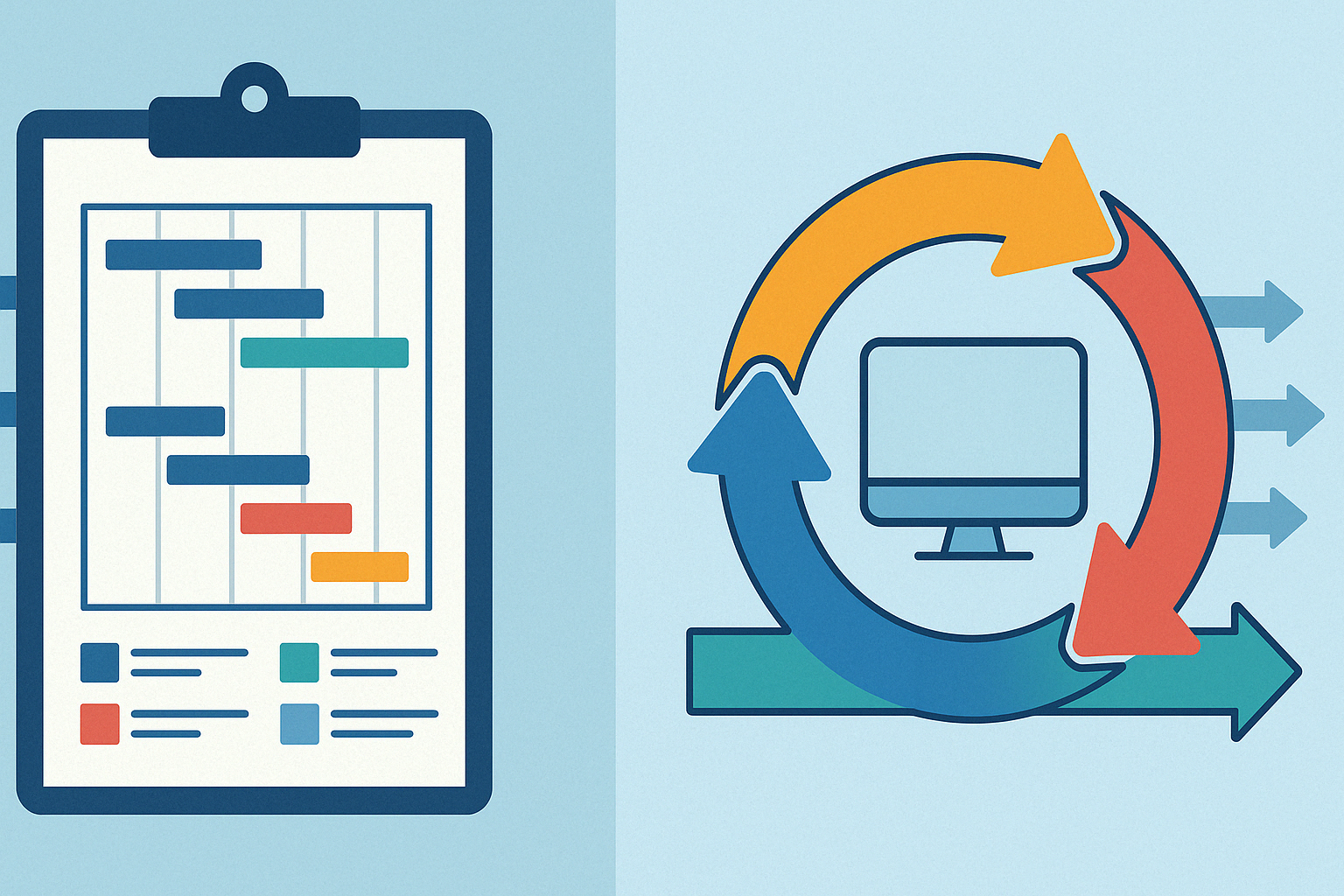
In project management, two primary approaches exist to manage and deliver projects—Predictive (Traditional) Approach and Adaptive (Agile) Approach. Choosing the right approach is crucial for project success, as each method caters to different types of projects and business environments. Let’s break down these two approaches and their associated frameworks.
1. Predictive Approach
Also known as the Traditional Approach or Plan-driven Approach, this method is linear and sequential. The focus is on detailed planning, where the scope, cost, and timeline are defined at the beginning of the project. This approach works best for projects with clear and fixed requirements.
Key Characteristics of the Predictive Approach:
- Sequential Phases: Each phase (Requirements, Design, Development, Testing, Deployment) follows the previous one without overlap.
- Fixed Scope: The requirements are gathered upfront and rarely change.
- Detailed Documentation: Emphasis on comprehensive planning and documentation.
- Low Flexibility: Changes during the project lifecycle can be difficult and costly to implement.
Frameworks in Predictive Approach:
- Waterfall Model – A linear and step-by-step process that flows downward like a waterfall. Each phase must be completed before moving to the next.
- Best for construction, manufacturing, and software projects with stable requirements.
- V-Model (Verification and Validation Model) – An extension of the Waterfall Model, where each development phase has a corresponding testing phase.
- Ideal for projects where quality and compliance are critical, such as medical or aerospace industries.
- PRINCE2 (Projects IN Controlled Environments) – A process-based framework focusing on governance and control of projects.
- Suited for large, complex projects in government or highly regulated industries.
2. Adaptive Approach
Also known as the Agile Approach, this method is iterative and flexible. The focus is on delivering small, functional increments of the project in short cycles, allowing for continuous feedback and adaptation. This approach is ideal for projects with evolving or unclear requirements.
Key Characteristics of the Adaptive Approach:
- Iterative and Incremental: Work is broken down into short iterations or sprints (usually 1–4 weeks).
- Flexibility: Requirements can evolve as the project progresses based on feedback.
- Collaboration: Close collaboration with stakeholders and cross-functional teams.
- Continuous Improvement: Focus on regular retrospectives to improve the process.
Frameworks in Adaptive Approach:
- Scrum – A lightweight framework based on sprints, roles (Scrum Master, Product Owner, Development Team), and regular ceremonies like stand-ups, sprint reviews, and retrospectives.
- Commonly used in software development but can be applied to other industries.
- SAFe (Scaled Agile Framework) – SAFe (Scaled Agile Framework) is a framework for scaling Agile practices across large enterprises. It helps organizations coordinate multiple Agile teams, align them with business goals, and deliver complex solutions efficiently and predictably. It’s designed to scale Agile, Lean, and DevOps principles beyond individual teams to the enterprise level.
- Suitable for large teams or multiple teams working together on complex projects.
- Kanban – Kanban is a visual workflow management method used to manage tasks, projects, or production processes in a flexible and efficient way. Tasks are displayed on a Kanban board, often divided into columns like: To Do, In Progress, Done.
- Ideal for operations, IT, and marketing projects where workflow is ongoing and repetitive.
- Lean – Focuses on minimizing waste and maximizing value delivery.
- Often combined with other Agile frameworks like Scrum.
- Scrumban – Scrumban is a hybrid framework that combines elements of Scrum and Kanban, blending structured sprints from Scrum with the continuous flow and visual workflow management of Kanban.
- Suitable for software development, DevOps, and marketing teams that require a combination of planning and adaptability.
How to Choose Between Predictive and Adaptive Approaches
The choice between predictive and adaptive approaches depends on several factors:
- Project Requirements: If requirements are well-defined and unlikely to change, the predictive approach is better. If they’re evolving, go with adaptive.
- Complexity and Uncertainty: High-complexity projects with high uncertainty benefit from adaptive approaches.
- Stakeholder Involvement: Adaptive approaches require continuous stakeholder involvement, whereas predictive approaches focus more on upfront engagement.
- Time and Budget Constraints: Predictive approaches are suitable for projects with strict deadlines and budgets, while adaptive approaches offer flexibility to adapt as the project evolves.
Conclusion
Both the predictive and adaptive approaches have their place in project management. The key is understanding the nature of your project and selecting the appropriate framework. Predictive models like Waterfall and V-Model provide stability and control, while adaptive frameworks like Scrum and SAFe offer flexibility and speed. In some cases, a hybrid approach that blends elements of both may be the best solution.
Use Case: Predictive vs. Adaptive Approach
Let’s consider a couple of real-world examples to demonstrate how and when these approaches are used.
1. Predictive Approach Use Case
Scenario: Building a Hospital
A construction company is tasked with building a 300-bed hospital. The project requirements are clearly defined from the start—architectural design, structural engineering, medical facilities, and safety regulations. There is little room for changes once construction begins.
Why Predictive Works:
- Clear and Stable Requirements: The hospital’s design and regulations are fixed.
- Strict Timelines and Budgets: Project managers must control costs and timelines precisely.
- Comprehensive Documentation: Detailed design and safety standards are documented before execution.
- Framework Used: Waterfall Model or V-Model. Each phase—Design, Procurement, Construction, Inspection—is completed sequentially.
2. Adaptive Approach Use Case
Scenario: Developing a Mobile Banking App
A fintech startup wants to develop a mobile banking app with innovative features. However, the requirements are not fully known at the beginning, as customer feedback will influence the final product. New features may need to be added based on evolving business needs.
Why Adaptive Works:
- Evolving Requirements: User feedback will continuously shape the app’s features.
- High Uncertainty: The startup is exploring untested features.
- Incremental Delivery: The app is delivered in iterations, allowing for early releases and continuous improvement.
- Framework Used: Scrum or SAFe. Development is done in sprints, with regular reviews and releases.
Hybrid Approach Use Case
Scenario: Large Enterprise Software Implementation
An insurance company is implementing a new claims management system. The core infrastructure must be built using the predictive approach, but some front-end features are expected to evolve based on end-user feedback.
Why Hybrid Works:
- Predictive for Infrastructure: The backend system has well-defined requirements and must be stable.
- Adaptive for Front-end Features: The user interface can be iteratively improved based on testing and feedback.
- Framework Used: Waterfall for core system development, Scrum for front-end improvements.
Conclusion: Use Case Summary
- Predictive Approach: Best for projects with stable requirements, fixed budgets, and strict timelines (e.g., construction, hardware engineering).
- Adaptive Approach: Ideal for projects with high uncertainty and evolving requirements (e.g., software development, product innovation).
- Hybrid Approach: Useful for complex projects that have both fixed and flexible elements.

